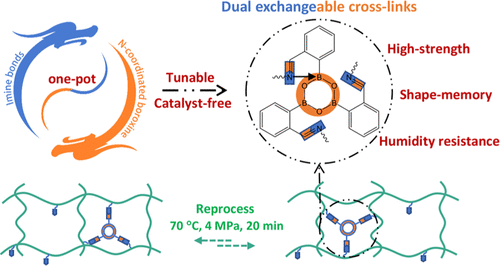当前位置:
X-MOL 学术
›
ACS Appl. Mater. Interfaces
›
论文详情
Our official English website, www.x-mol.net, welcomes your
feedback! (Note: you will need to create a separate account there.)
Assembling of Reprocessable Polybutadiene-Based Vitrimers with High Strength and Shape Memory via Catalyst-Free Imine-Coordinated Boroxine.
ACS Applied Materials & Interfaces ( IF 8.3 ) Pub Date : 2020-06-26 , DOI: 10.1021/acsami.0c09712 Yinxin Yang 1, 2 , Lingyun Huang 1, 2 , Ruiyao Wu 1, 2 , Weifeng Fan 1 , Quanquan Dai 1 , Jianyun He 1 , Chenxi Bai 1, 2
ACS Applied Materials & Interfaces ( IF 8.3 ) Pub Date : 2020-06-26 , DOI: 10.1021/acsami.0c09712 Yinxin Yang 1, 2 , Lingyun Huang 1, 2 , Ruiyao Wu 1, 2 , Weifeng Fan 1 , Quanquan Dai 1 , Jianyun He 1 , Chenxi Bai 1, 2
Affiliation

|
Vitrimers endow cross-linked polymers with malleability and reprocessability via exchange reactions. However, designing of reprocessable, shape-memory polymer materials with high strength via a catalyst-free method remains a challenge under mild conditions. Here, we propose a facile strategy to address this dilemma by introducing the exchangeable imine bond and N-coordinated boroxine into a polybutadiene (PB)-based network. Specifically, PB grafted with 2-aminoethanethiol is reacted with the formyl group of phenylboronic acid and dehydrated to form a dual-dynamic covalently cross-linked network at room temperature. The dynamic network draws on the advantage of imine (toughness) and N-coordinated boroxine (strength), making the PB-based materials exhibit favorable malleability, mechanical property, reprocessability, and thermal-induced shape-memory behavior. We can obtain customized high mechanical properties by tuning the cross-linking density, and the tensile strength reaches a high value (12.35 MPa) without fillers or any other additives. Meanwhile, the unique network framework makes the material recycle over several times without sacrificing its property. This work presents a facile and effective approach to achieve a multifunctional polymer with customized attributes. Besides, this strategy can recycle end-of-life rubber to alleviate environmental pollution and provide inspiration for fabricating targeted materials by uniting the dynamic covalent or noncovalent bonds.
中文翻译:

通过无催化剂的亚胺配位的硼氧烷组装具有高强度和形状记忆的可再加工的聚丁二烯基三聚体。
Vitrimers通过交换反应赋予交联聚合物以延展性和可再加工性的能力。然而,在温和条件下通过无催化剂的方法设计具有高强度的可再加工的形状记忆聚合物材料仍然是一个挑战。在这里,我们提出了一种简单的策略来解决此难题,方法是将可交换的亚胺键和N-配位的环硼氧烷引入基于聚丁二烯(PB)的网络中。具体地,将接枝有2-氨基乙硫醇的PB与苯基硼酸的甲酰基反应并在室温下脱水以形成双动态共价交联网络。动态网络利用亚胺(韧性)和N配位的环硼氧烷(强度)的优势,使PB基材料具有良好的延展性,机械性能,可再加工性,和热诱导的形状记忆行为。我们可以通过调整交联密度来获得定制的高机械性能,并且在没有填料或任何其他添加剂的情况下,抗拉强度达到很高的值(12.35 MPa)。同时,独特的网络框架使材料可以多次回收,而不会牺牲其性能。这项工作提出了一种简便有效的方法来实现具有定制属性的多功能聚合物。此外,该策略可以回收报废的橡胶以减轻环境污染,并通过结合动态共价或非共价键为制造目标材料提供灵感。35 MPa),无需填料或任何其他添加剂。同时,独特的网络框架使材料可以多次回收,而不会牺牲其性能。这项工作提出了一种简便有效的方法来实现具有定制属性的多功能聚合物。此外,该策略可以回收报废的橡胶以减轻环境污染,并通过结合动态共价或非共价键为制造目标材料提供灵感。35 MPa),无需填料或任何其他添加剂。同时,独特的网络框架使材料可以多次回收,而不会牺牲其性能。这项工作提出了一种简便有效的方法来实现具有定制属性的多功能聚合物。此外,该策略可以回收报废的橡胶以减轻环境污染,并通过结合动态共价或非共价键为制造目标材料提供灵感。
更新日期:2020-07-22
中文翻译:

通过无催化剂的亚胺配位的硼氧烷组装具有高强度和形状记忆的可再加工的聚丁二烯基三聚体。
Vitrimers通过交换反应赋予交联聚合物以延展性和可再加工性的能力。然而,在温和条件下通过无催化剂的方法设计具有高强度的可再加工的形状记忆聚合物材料仍然是一个挑战。在这里,我们提出了一种简单的策略来解决此难题,方法是将可交换的亚胺键和N-配位的环硼氧烷引入基于聚丁二烯(PB)的网络中。具体地,将接枝有2-氨基乙硫醇的PB与苯基硼酸的甲酰基反应并在室温下脱水以形成双动态共价交联网络。动态网络利用亚胺(韧性)和N配位的环硼氧烷(强度)的优势,使PB基材料具有良好的延展性,机械性能,可再加工性,和热诱导的形状记忆行为。我们可以通过调整交联密度来获得定制的高机械性能,并且在没有填料或任何其他添加剂的情况下,抗拉强度达到很高的值(12.35 MPa)。同时,独特的网络框架使材料可以多次回收,而不会牺牲其性能。这项工作提出了一种简便有效的方法来实现具有定制属性的多功能聚合物。此外,该策略可以回收报废的橡胶以减轻环境污染,并通过结合动态共价或非共价键为制造目标材料提供灵感。35 MPa),无需填料或任何其他添加剂。同时,独特的网络框架使材料可以多次回收,而不会牺牲其性能。这项工作提出了一种简便有效的方法来实现具有定制属性的多功能聚合物。此外,该策略可以回收报废的橡胶以减轻环境污染,并通过结合动态共价或非共价键为制造目标材料提供灵感。35 MPa),无需填料或任何其他添加剂。同时,独特的网络框架使材料可以多次回收,而不会牺牲其性能。这项工作提出了一种简便有效的方法来实现具有定制属性的多功能聚合物。此外,该策略可以回收报废的橡胶以减轻环境污染,并通过结合动态共价或非共价键为制造目标材料提供灵感。











































 京公网安备 11010802027423号
京公网安备 11010802027423号